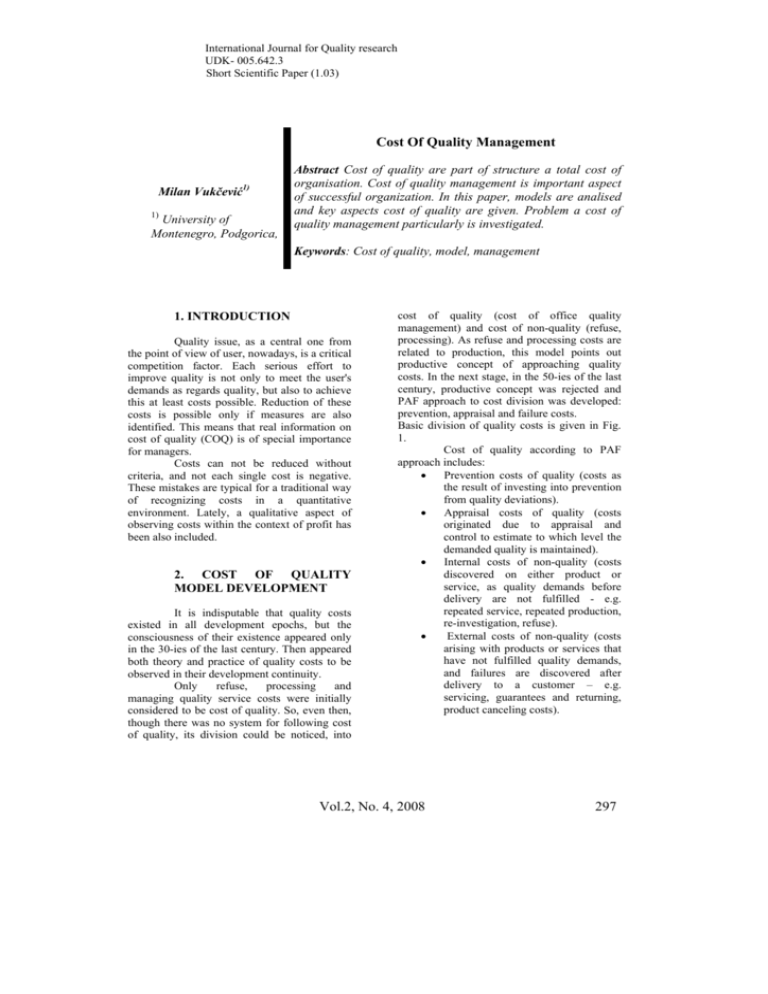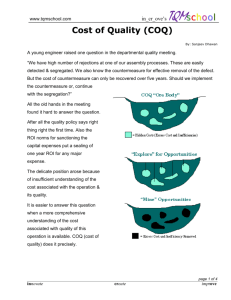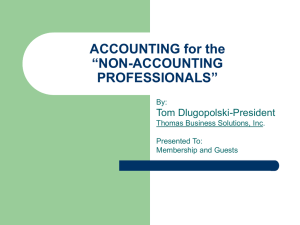Cost Of Quality Management - International Journal for Quality
advertisement

International Journal for Quality research UDK- 005.642.3 Short Scientific Paper (1.03) Cost Of Quality Management Milan Vukčević1) 1) University of Montenegro, Podgorica, Abstract Cost of quality are part of structure a total cost of organisation. Cost of quality management is important aspect of successful organization. In this paper, models are analised and key aspects cost of quality are given. Problem a cost of quality management particularly is investigated. Keywords: Cost of quality, model, management 1. INTRODUCTION Quality issue, as a central one from the point of view of user, nowadays, is a critical competition factor. Each serious effort to improve quality is not only to meet the user's demands as regards quality, but also to achieve this at least costs possible. Reduction of these costs is possible only if measures are also identified. This means that real information on cost of quality (COQ) is of special importance for managers. Costs can not be reduced without criteria, and not each single cost is negative. These mistakes are typical for a traditional way of recognizing costs in a quantitative environment. Lately, a qualitative aspect of observing costs within the context of profit has been also included. 2. COST OF QUALITY MODEL DEVELOPMENT It is indisputable that quality costs existed in all development epochs, but the consciousness of their existence appeared only in the 30-ies of the last century. Then appeared both theory and practice of quality costs to be observed in their development continuity. Only refuse, processing and managing quality service costs were initially considered to be cost of quality. So, even then, though there was no system for following cost of quality, its division could be noticed, into cost of quality (cost of office quality management) and cost of non-quality (refuse, processing). As refuse and processing costs are related to production, this model points out productive concept of approaching quality costs. In the next stage, in the 50-ies of the last century, productive concept was rejected and PAF approach to cost division was developed: prevention, appraisal and failure costs. Basic division of quality costs is given in Fig. 1. Cost of quality according to PAF approach includes: • Prevention costs of quality (costs as the result of investing into prevention from quality deviations). • Appraisal costs of quality (costs originated due to appraisal and control to estimate to which level the demanded quality is maintained). • Internal costs of non-quality (costs discovered on either product or service, as quality demands before delivery are not fulfilled - e.g. repeated service, repeated production, re-investigation, refuse). • External costs of non-quality (costs arising with products or services that have not fulfilled quality demands, and failures are discovered after delivery to a customer – e.g. servicing, guarantees and returning, product canceling costs). Vol.2, No. 4, 2008 297 COST OF QUALITY Cost of quality Cost of non-quality Prevention Internal Appraisal External Direct Indirect Figure 1. Cost of quality division This means that quality cost calculation in this case is performed according to model 1. COQ=P+A+IF+EF (1) Similarly to PAF model, Krosby's cost of quality model sees quality as "an accordance with demands" thus defining costs as: • Cost of conformance - COC. • Cost of non-conformance - CONC. Cost of quality is defined according to model 2. COQ=COC+CONC (2) COC costs include prevention and appraisal costs, whereas CONC costs correspond to non-quality costs. This mean that these two models, though of different terminology, are often identical. In further stages of theory and practice quality development there appear, as special categories, opportunity costs (OC) and invisible costs like exceeding requirements (ExR). They often express COQ as a lost income and unrealized profit. Opportunity cost are related to unrealized profit due to user's loss and income reduction because of non coordination. Exceeding requirements refer to the costs of ensuring unnecessary and unimportant information or services not being even demanded. These costs are included into classical PAF approach so cost of quality is found according to model 3. COQ=P+A+IF+EF+OC+ExR (3) Contemporary stage of quality cost development started by applying ISO 298 9000:2000, as well as ISO 9004:2000. This consistent pair has demands asking for the necessity of fallowing cost of quality: • obligation of planning and securing resource availability, • resource management necessarily includes activities related to financial effects, • process approach and management are not possible without cost resource investment into processes. This enabled the development of process cost model - PCS. Process cost is a summary cost of conformance and nonconformance of the investigated process. This model is also developed for following cost of quality focused on process rather than on product or service. PCS is an appropriate method for estimating quality cost within total quality management (TQM), as modeling costs is more successful by its application than by using classical PAF approach. The most measurable COQ model is activity - based costing - ABC. Through ABC approach, correct cost for different cost object is achieved by translating cost resources to respective activities and activity cost to object cost. This means that ABC approach is, in fact, not COQ model. It is an alternative model to be possibly of quality cost among products, thus enabling a more efficient cost of quality management. 3. KEY QUALITY COST ASPECTS OF Cost of quality concept was practically M. Vukčević introduces half a century ago as an integral part of quality management. For a long time, this concept was used to identity possibilities of significant saving. On option of many zealous workers in quality field, this concept, colliding with time, should be significantly changed. In the previous period, two key ideas were used. The first one is the idea of optimal quality level emphasizing minimization of total quality cost Fig. 2. Extraprofit Cost of non-quality Cost of quality Total cost of quality Cost € Quality Minimal quality Maximal quality Optimal quality Figure 2. Cost of quality optimization The second one is characterization of cost quality consisting of four part: prevention, investigation, internal cost of non quality and external cost of non-quality. In the early 80-ies, the issue of optimal quality levels become very up-to-date. There were noticed many examples where, by process changing, the basic form of cost curve was radically changed and optimum significantly displaced. For example, implementing modern statistical methods of k ∞ ∞ quality control on production line and reducing cost of final control, it is possible to realize output of higher quality at lower costs. Then, a key idea of modern quality cost theory was observed: quality cost curve shape should be changed rather than persistently seeking a very fluid minimum point. Japanese companies were first to focus themselves to finding out way to improve quality at cost reduction (Fig. 3). k Total cost of quality Cost of nonquality Cost of quality 0 Quality% a) Cost of nonquality Cost per unit of product Cost per unit of product Total cost of quality 100 Excellent point Cost of quality 0 Quality % b) 100 Figure 3. Classica (a) and modern (b) model of cost of quality optimization Vol 2, No. 4, 2008 299 Second key idea that contributed to changing classical approach of quality cost is the change in non-quality cost. E.g. making products easier to be maintained and repaired, non-quality cost decreased drastically (Fig. 4). Cost of quality characterization concept beyond parts was also re-investigated in the 90-ies. The problem is the very term. Quality is an integral term for products and services, so, how is it possible to separate and distinguish quality acquisition cost from product or service cost. A real problem is, if we try to decrease cost of quality, we often neglect ignore main exit: minimization of integral total cost of production, not a part of it. Cost of quality Prevention ( P) Appraisal (A) Failure (F) Reduce cost of nonquality Increase cost inspection and investigation Increase cost of prevention Time Figure 4. Technology of optimizing cost of quality through allocation resources There is a problem in this approach: how to define cost of prevention. Each company undertakes a number of activities to prevent non-quality, starting from market research to choosing a supplier and staff training. All these activities belong to cost of prevention causing a situating where almost all realization cost are included in cost of prevention. The only acceptable fact seems to be concentrating on cost of non-quality and allocating prevention measures for immediate problem. Seeking a theoretical minimum and comparing it to the real cost is the best way to identity the possibilities that were not noticed 300 before, this leading to a more real cost realization. 4. COST OF MANAGEMENT QUALITY Management is a basic phase when working with cost of quality. To manage cost of quality, it is necessary to: make a system of following quality cost, file document and take improvement measures. Documentation of quality cost follow-up is highly positioned in a total quality system documentation. Hierarchy is shown in Fig. 5. M. Vukčević Figure 5. Hierarchy of quality cost follow-up documentation The essence of quality cost • Making and distributing reports on management is a well organized system of cost of quality. collecting cost of quality within an organization, as well as its separation which The most complex activity appears to may be based on different cost classifications be allocation of quality cost per cost places, so (PAF model, conformance and nonit is carried out according to phases - Fig. 6. conformance cost, life cycle model, etc). 1. Evidence of all the places of total Implementation of quality cost cost origin. follow-up system implies a number of 2. Classification of all the cost places activities: and cost of quality. • Cost place determination. 3. Separating total cost of quality from other costs. • Evidence of total cost per cost places. 4. Division and categorization of • Allocating cost of quality per cost quality cost according to places of places. cost • Calculating cost of quality parameters. . Note place of total cost appear Classification place of cost with cost of quality Separating cost of quality according to others cost Detailed division and categorize cost of quality Figure 6. Separating cost of quality according to cost places Cost of quality parameters, in conformity with the principle of continual improvement may be obtained by comparing cost of quality of an observed period of time with the quality cost of previous time. For the case of PAF model, we suggest indexes K1i (4), and K2i (5) to be used as quality cost parameters: Vol 2, No. 4, 2008 301 K1i = Ci ( P) + Ci ( A) C1 ( P) + C1 ( A) K 2i = where Ci i=1,2,... are summary coefficients per years and are related to the costs of preventive, appraisal, internal and external errors. An example of a domestic firm, in Fig. 7., shows that investing in cost of quality has as its consequence a fall in cost of nonquality and total quality cost (K). i = 1,2,... Ci ( IF ) + Ci ( EF ) C1 ( IF ) + C1 ( EF ) (4) i = 1,2,... (5) 1,6 K1 K K2 1,4 1,2 K1 1 K2 0,8 K 0,6 0,4 0,2 1 2 3 4 5 years Figure 7. Example of quality index change. 5. CONCLUSIONS In the sense of further contribution to cost of quality knowledge, for the phase being there may be expected: • Further cost of quality classification to enable a simpler recognition and follow-up in services. • Development of consciousness on cost of quality existence in other fields as well (sports clubs, government of a state, national economy, school, etc.) • Reaching consensus on types of quality costs and making model for their fallow-up to compare organizations according to cost of quality criteria. • Making fallow-up and evidence of quality cost model appropriate to complex systems: cost of 302 • environment management, cost of quality security, cost of health quality and protection at work, etc. Treating cost of quality in relation to time point to establish a unique scale parameter through one of relations (5) or (6). F=P(F/P,i%,N) (5) P=F(P/F,i%,N) (6) where: P - immediate equivalent value F - future equivalent value i% - intres N - number of interest periods Obviously, it is necessary to make a unique, generally accepted methodology for cost of quality follow-up to quicken the development in this field. M. Vukčević REFERENCES [1] Arsovski S.: Profiting by quality, CIM centre, Mechanical Engineering Faculty, Kragujevac, 1998. [2] Drljaca M.: Little quality encyclopedia - cost and qualities, Oskar, Zagreb, 2004. [3] Feigenbaum A., Total Quality Control, Third Edition, Mc Graw Hill, 1991. [4] Juran J.M., Quality Control Handbook, Fifth Edition, Mc Graw Hill, 2001. [5] Schiffauerova A., Thomson V., A review of research on cost of quality models and best practices, International Journal of Quality and Reliability Management, Vol.23. No.4, 2006. [6] Mrdja V.: Cost of quality management, Concept No7, 2007. [7] Perovic J.M.: Management - Informatics - Quality, CIM centre, Mechanical Engineering Faculty, Kragujevac, 1999. [8] Arsovski S., Quality Economic Management, Faculty of Mechanical Engineeering, Kragujevac, 2002. Received: 03.09.2008 Accepted: 08.10.2008 Vol 2, No. 4, 2008 Open for discussion: 1 Year 303






